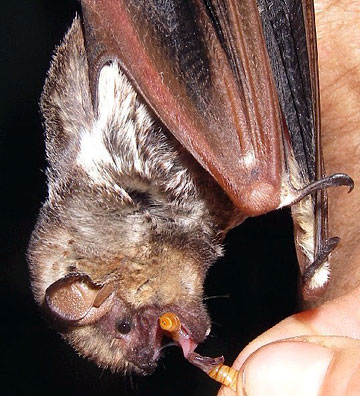 VIA WEST HAWAII TODAY / ASSOCIATED PRESS
In a photo provided by Three Ring Ranch Exotic Animal Sanctuary, this Hawaiian hoary bat rescued by wildlife experts is seen being fed in Kailua-Kona. CLICK FOR LARGE |
|
Rescuers nurse rare native bat back to health
Associated Press
KAILUA-KONA » Wildlife experts rescued and nursed back to health an endangered Hawaiian hoary bat after it was found lying listless, dehydrated and starving on a car.
A worker at a waste-water treatment plant in Kona spotted the bat Wednesday after the animal appeared to have fallen from a tree. It was not moving.
Responding to a call from the local Humane Society, Ann and Norm Goody of the Three Ring Ranch Exotic Animal Sanctuary in Kailua-Kona took in the bat.
Ann Goody warmed the animal on her hand and fed it fluids and mealworms.
"The (bat) was too cold and dehydrated at first to eat, but with a bit of time it began to lick the delicious bug insides from its lips," she wrote. "In a few hours it was able to eat more."
Over the course of three days, the female mammal's weight rose to 0.53 ounces from 0.42 ounces and was ready to be set free at the Kaloko-Honokohau National Historical Park.
Goody said it was important to release the animal along the coastline because that is the bat's feeding territory. Male bats are usually around the coastline in the fall, and females in the summer and spring, she said.
The Goodys took the bat to the park at 5:30 p.m. Friday. It hung from a low branch for a while, taking a nap and waking occasionally. It ate a bite of mealworm.
Almost two hours later, it took flight.
"Off she went. It was just great, it was perfect," Goody said.
The Hawaiian hoary bat has been classified an endangered species since the 1970s. The U.S. Fish and Wildlife Service estimates its population at about 2,500.
Shrinking natural habitats have made it difficult for the animals to thrive, but they are still commonly seen on Hawaii, Kauai and Maui. They are rarely seen on Oahu, according to the Honolulu Zoo.
The bat is Hawaii's only native land mammal, though there is fossil evidence of at least one other Hawaiian bat species.

